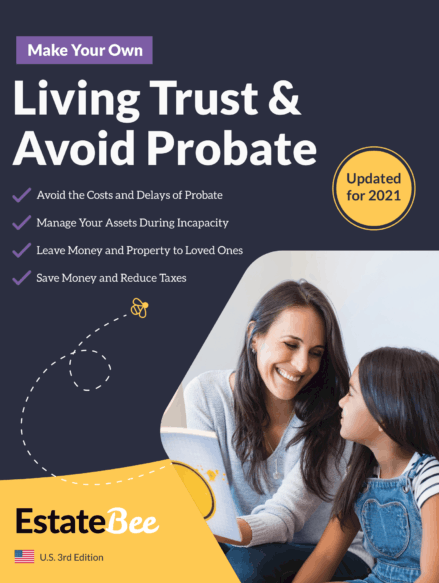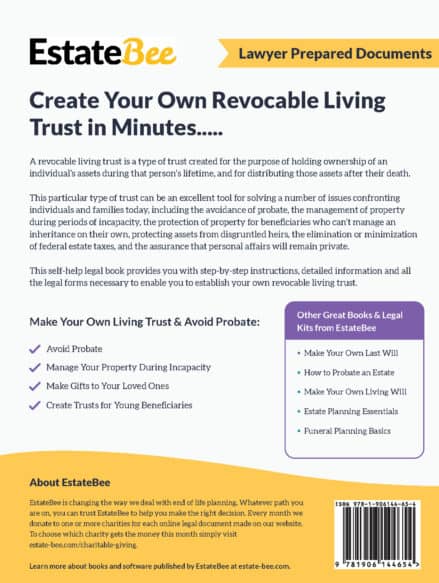
Make Your Own Living Trust & Avoid Probate
In Make Your Own Living Trust and Avoid Probate, you’ll learn all you need to know about living trusts, their advantages and disadvantages, the tax implications, the alternatives to living trusts and, of course, how to easily make your own.
- Create your own legally valid revocable living trust – step-by-step.
- Avoid the delays and costs of probate.
- Manage your assets during incapacity.
- Leave money and property to your loved ones.
- Save money and reduce taxes.
With detailed information, easy-to-follow instructions, helpful worksheets and all of the forms necessary, we show both individuals and couples how to avoid the otherwise inevitable delays and costs of probate by preparing a revocable living trust and using other simple probate avoidance strategies.
Description
When a person dies, their assets often have to go through a formal court supervised process called probate. During that process, the deceased’s assets are often frozen until probate is complete. During the intervening period, the deceased’s family and other beneficiaries may be unable to access those assets. This can often cause them financial hardship as they wait months, and in some cases years, to have the assets released.
Add to this the fact that legal and probate fees can cost up to 11% of the gross value of an estate, and it’s not difficult to see why so many people want to avoid probate.
Fortunately, probate can (for the most part) be easily avoided by making a revocable living trust.
It’s relatively easy to make a living trust. All you need to do is complete and sign a revocable living trust agreement naming yourself as both grantor (the creator of the living trust) and trustee (the person who manages the assets transferred to the living trust). So, it’s essentially an agreement between you as grantor and you as trustee – no third parties involved. Once the living trust is created, you then transfer some or all of your assets to the trust. As trustee, you then take over the management of those same trust assets – which means you retain the use of and control over those assets.
When you die, the assets in your living trust are distributed by a successor trustee (which is little like an executor of a will, and is someone who you name in your living trust) to the beneficiaries named in your living trust agreement – in much the same way as assets are transferred to beneficiaries under a will.
However, importantly, as the assets are held in the trust’s name rather than in your personal name, they will not form part of your estate for probate purposes. As a result, they will not need to go through the probate process and can therefore be distributed quite quickly after you die.
EstateBee’s lawyers have created a straightforward and easy to understand book to show you how to:
- easily create your own revocable living trust & avoid probate;
- transfer property to and from your living trust;
- amend and revoke your living trust;
- manage your living trust;
- make gifts to beneficiaries;
- make provisions for the management of property gifted to young beneficiaries; and
- much more.
If you like this book, please leave a Review on Amazon.
Table of Contents
An Introduction to Living Trusts and Probate
Chapter 1 – Probate and Why People Try to Avoid it
Overview of the Probate Process
What are the Steps Involved in Probate or Intestate Administration?
How Long Does it Take?
How Much will Probate Cost?
Disadvantages of Probate
Advantages of Probate
Conclusion
Chapter 2 – Probate Avoidance Measures
Introduction
Advantages and Disadvantages of Probate
Avoidance Measures
Payable on Death or Transfer on Death Accounts
Transfer on Death Securities
Retirement Accounts
Joint Accounts
Custodial Accounts
Savings Bonds
Life Insurance Proceeds
Joint Ownership of Property
Revocable Living Trust
Lifetime Gifts
Probate Free Transfers of Assets
Simplified Transfer Procedures for “Small Estates
Chapter 3 – An Introduction to Trusts
What exactly is a Trust?
The Origin of Trusts
Basic Types of Trusts
What Exactly are Living Trusts?
Parties to a Living Trust
The Development and Growing Use of Living Trusts
Chapter 4 – Advantages and Disadvantages of Living Trusts
Advantages of Using a Living Trust
Disadvantages of Living Trusts
Chapter 5 – Types of Living Trusts
What Type of Trust do You Need?
Living Trust for an Individual
Living Trusts for Couples
Individual Living Trusts
Basic Shared Living Trusts
Basic AB Trusts
AB Disclaimer Trust
Conclusion
Chapter 6 – Successor Trustees
The Role of the Initial Trustee
Appointing a Co-Trustee
Appointing a Successor Trustee
Appointing an Alternate Successor Trustee
The Role of the Successor Trustee
Payment of Compensation to Successor Trustees
Entitlement to act as a Successor Trustee
Whom Should You Choose as a Successor Trustee?
Successor Trustee’s Duties
Changing Trustees
Removing a Trustee
Conclusion
Chapter 7 - Making gifts under Your Living Trust
Types of Gifts
What Is a Beneficiary?
Types of Beneficiaries
Gifts to Spouses
Gifts to Minors
Gifts to Charities
Failed Gifts
Disinheritance
Disinheriting Your Spouse
Disinheriting Your Child
Children’s Inheritance & Property Guardians
Failing to Designate a Property Guardian
Options for Property Management
Chapter 8 - Estate Taxes
Estate Taxes
Federal Estate and Gift Tax
How to Determine the Estate Tax?
State Taxes
Marital Deduction
Non-Citizen Spouses
Charitable Deductions
Charitable Remainder Trust
Charitable Lead Trust
Other Ways to Reduce Estate Taxes
Lifetime Gifts
Irrevocable Life Insurance Trusts
Family Limited Partnerships
Special Use Real Estate Valuation
Conclusion
Chapter 9 - Transferring Assets to Your Living Trust
Introduction
What Assets Should Be Put in Your Living Trust?
Transferring Title in Assets to a Living Trust
Employer Identification Numbers
How to Transfer Specific Property to a Trust
Real Estate
Tangible Personal Property
Cars, Boats and Other Vehicles
Cash Accounts
United States Savings Bonds
Broker Accounts
Publicly Traded Stocks and Bonds
Retirement Plans
Life Insurance/Annuities
Other Property
Chapter 10 - Executing and Making Changes to Your Living Trust
Executing Your Living Trust
Reviewing Your Living Trust
Amending Your Living Trust Agreement
Transferring and Removing Property from the Trust
Revocation of Your Living Trust
Chapter 11 - Administering a Living Trust After the grantor Dies
The Successor Trustee’s Role
Obtaining Certified Copies of the Death Certificate
Obtaining Tax Identification Number for the Trust
Notifying Beneficiaries
Collecting and Managing Trust Assets
Preparing and Filing Tax Returns
Transferring Property to Beneficiaries
Administering a Child’s Trust
Conclusion
Chapter 12 - Ancillary Estate Planning Documents
What is a ‘Pour-Over Will?’
Avoiding Conflicts between Your Living Trust & Your Will
Planning for Incapacity - Power of Attorney for Finance & Property
Planning for Incapacity – Advance Healthcare Directives
Living Wills
Healthcare Power of Attorney
Appendix 1 - Instructions for Completing Your Documents
Appendix 2 - Revocable Living Trust Documents
Appendix 3 - Miscellaneous Clauses for Use in a Revocable Living Trust
Appendix 4 - Deeds of Assignment
Appendix 5 - Certifications of Trust
Appendix 6 - Revocable Living Trust Amendment Agreements
Appendix 7 - Notice for Revocation of a Living Trust Agreement
Appendix 8 - Estate Planning Worksheet
Forms
The following forms are included on this book:
- Revocable Living Trust for an Individual
- Revocable Living Trust for a Couple
- AB Revocable Living Trust for a Couple
- Deed of Assignment for Use with a Revocable Living Trust for an Individual
- Deed of Assignment for Use with a Revocable Living Trust for a Couple
- Certification of Trust for Use with a Revocable Living Trust for an Individual
- Certification of Trust for Use with a Revocable Living Trust for a Couple
- Revocable Living Trust Agreement (Amendment Agreement) for an Individual
- Revocable Living Trust Agreement (Amendment Agreement) for a Couple
- Notice of Revocation
Why Choose Estatebee
We’re proud to have helped thousands of people make online wills, trusts and powers of attorney over the past 20 years.
- Save Money – Our service is simpler and cheaper than using a lawyer.
- Lawyer Prepared Documents – You will be using documents which have been prepared, reviewed and pre-approved by lawyers with years of estate planning experience.
- Compliant with US Laws – You will be using tried and tested legal documents specifically tailored to comply with the laws of each state in the United States (except Louisiana).
- Advanced Features – Your documents will contain advanced lawyer-approved provisions not usually found in standard run-of-the-mill documents you find online.
- 20 Years in Business – EstateBee was one of the first businesses to start selling estate planning documents online back in 2000.
- Trusted by Thousands – We have helped thousands of people to make wills, trusts, and powers of attorney over the past 20 years.
- Bank Level Security – Your information is encrypted and secured safely using the same encryption technology used by banks.

Managed by lawyers
EstateBee was founded in 2000 by, and is managed by, experienced lawyers who are recognised experts in their fields.

Easy to use
We use our 20+ years of experience to help you figure out what you really want in a simple jargon-free way.

Help at every stage
Our customers are everything to us. So, we provide help to you at every stage of the document creation process.
Reviews (0)
You must be logged in to post a review.
We’ve helped raise millions for charity through donations left in our customers’ wills…










Our expert team is here to help
- Expert support every step of the way
- Phone or send us a message online
- Phone lines open 9am-5pm ET, Monday to Friday
Confirm Your Email Address to Receive Your Discount
, thanks for joining EstateBee.
To receive your 20% discount code, you’ll need to verify your email address and activate your account.
We’ve sent an activation link to you by email to . Just click on the link in the email, confirm your details and you’re good to go.
Best Wishes,
EstateBee Team





Reviews
There are no reviews yet.